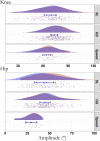Repeated practice runs during on-snow training do not generate any measurable neuromuscular alterations in elite alpine skiers
- PMID: 35966108
- PMCID: PMC9372580
- DOI: 10.3389/fspor.2022.829195
Repeated practice runs during on-snow training do not generate any measurable neuromuscular alterations in elite alpine skiers
Abstract
Background: Alpine skiers typically train using repeated practice runs requiring high bursts of muscle activity but there is little field-based evidence characterizing neuromuscular function across successive runs.
Purpose: To examine the impact of repeated ski runs on electromyographic activity (EMG) of the knee extensors and flexors in elite alpine skiers.
Methods: Nineteen national team alpine skiers were tested during regular ski training [Slalom (SL), Giant Slalom (GS), Super Giant Slalom and Downhill (Speed)] for a total of 39 training sessions. The surface EMG of the vastus lateralis (VL), rectus femoris (RF), vastus medialis (VM), biceps femoris (BF) and semimembranosus/semitendinosus (SMST) muscles was continuously recorded along with right knee and hip angles. The EMG root mean square signal was normalized to a maximal voluntary contraction (%MVC). The first and fourth runs of the training session were compared.
Results: There was no meaningful main effect of run on EMG relative activation time or mean power frequency beyond the skier's intrinsic variability. However, EMG activity of the vastii increased from the first to the fourth run in SL [VM, ~+3%MVC for IL and outside leg (OL), p = 0.035)], speed (VL, IL:+6%/OL:+11%, p = 0.015), and GS (VM, IL:0/OL:+7%, p < 0.001); the later with an interaction with leg (p < 0.001) due to a localized increase on the OL. The run time and turn time did not change from the first to the fourth run. There were no meaningful changes in angular velocities, amplitude of movement, or maximal and minimal angles.
Conclusion: Neuromuscular activity remains highly stable in elite skiers with low variability across four runs.
Keywords: alpine ski; elite athlete; injury prevention; muscle fatigue; surface electromyogram; variability; winter sport.
Copyright © 2022 Alhammoud, Girard, Hansen, Racinais, Meyer, Hautier and Morel.
Conflict of interest statement
The authors declare that the research was conducted in the absence of any commercial or financial relationships that could be construed as a potential conflict of interest.
Figures







Similar articles
-
Fatigue-induced changes in electromyographic activity after repeated racing turns: a pilot study.Eur J Appl Physiol. 2025 May;125(5):1423-1435. doi: 10.1007/s00421-024-05691-0. Epub 2024 Dec 21. Eur J Appl Physiol. 2025. PMID: 39707012
-
On-Field Ski Kinematic According to Leg and Discipline in Elite Alpine Skiers.Front Sports Act Living. 2020 May 15;2:56. doi: 10.3389/fspor.2020.00056. eCollection 2020. Front Sports Act Living. 2020. PMID: 33345047 Free PMC article.
-
Joint kinematic responses of Olympic medallist skiers to repeated slalom runs.Exp Physiol. 2024 Sep 5. doi: 10.1113/EP091743. Online ahead of print. Exp Physiol. 2024. PMID: 39236311
-
Biomechanical factors influencing the performance of elite Alpine ski racers.Sports Med. 2014 Apr;44(4):519-33. doi: 10.1007/s40279-013-0132-z. Sports Med. 2014. PMID: 24374655 Review.
-
Physiology of Alpine skiing.Sports Med. 1988 Oct;6(4):210-21. doi: 10.2165/00007256-198806040-00003. Sports Med. 1988. PMID: 3067309 Review.
Cited by
-
Addressing the unresolved challenge of quantifying skiing exposure-A proof of concept using smartphone sensors.Front Sports Act Living. 2023 May 9;5:1157987. doi: 10.3389/fspor.2023.1157987. eCollection 2023. Front Sports Act Living. 2023. PMID: 37229363 Free PMC article.
-
Fatigue-induced changes in electromyographic activity after repeated racing turns: a pilot study.Eur J Appl Physiol. 2025 May;125(5):1423-1435. doi: 10.1007/s00421-024-05691-0. Epub 2024 Dec 21. Eur J Appl Physiol. 2025. PMID: 39707012
References
-
- Akutsu T., Kiryu T., Ushiyama Y., Murayama T. (2008). Evaluation of functional activities during skiing exercise by knee joint angles and surface EMG signals. Trans. Soc. Instrum. Control Eng. 44, 905–910. 10.9746/ve.sicetr1965.44.905 - DOI
LinkOut - more resources
Full Text Sources
Miscellaneous

